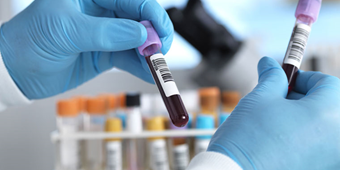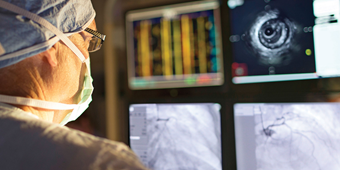Stopping the ‘Silent Killer’: Abdominal Aortic Aneurysm

Find Your Perfect Match
Answer a few questions and we'll provide you with a list of primary care providers that best fit your needs.
That pain in your stomach may be nothing more than those nachos you ate last night. Or it could signal a more serious problem — an abdominal aortic aneurysm, sometimes called “the silent killer.” The aorta is the largest blood vessel in your body, delivering oxygen-rich blood from your heart to the rest of your body. An aortic aneurysm is a bulge that develops in an area where the aortic wall is weak. If it bursts, it can cause severe bleeding and even death.
Causes
Many things can cause the breakdown of the aortic wall tissues and lead to an abdominal aortic aneurysm. Even experts don’t know exactly what triggers an aneurysm. But some believe that atherosclerosis, a buildup of plaque in the artery, plays a role. Risks include:
- Smoking
- High blood pressure
- High cholesterol
- Male (occurs four to five times more often in men than women)
- Family history (first-degree relatives such as father or brother)
- Genetic factors
- Age — 50+ for men, 60+ for women
- Diabetes
- Obesity
- Inflammation that causes a weakening of the aortic artery wall
Symptoms
Often, an aortic abdominal aneurysm has no symptoms, which is why it’s called the “silent killer.” An aneurysm is often found by chance during an exam for a different medical condition. It’s important to know that sudden, severe pain in the back or abdomen can mean that the aneurysm is about to rupture — signaling a life-threatening emergency. Symptoms of a rupture include:
- Pain in the abdomen, chest, lower back or groin area or back, which may be severe, sudden, persistent or constant
- Passing out
- Clammy skin
- Dizziness
- Nausea and vomiting
- Rapid heart rate
- Shock
Diagnosis
First, your doctor will do a complete medical history and exam. Other tests may include:
- CT (computed tomography scan): Shows detailed images of your body
- MRI (magnetic resonance imaging): Produces detailed images of organs and body structures
- Echocardiogram (also called echo): Evaluates the structure and function of the heart and heart valves
- TEE (transesophageal echocardiogram): Checks for aneurysm, the condition of the heart valves or a tear of the aortic lining
- Chest X-ray: Makes images of internal tissues, bones and organs
- Arteriogram (angiogram): Creates an X-ray image of the blood vessels to assess conditions like aneurysm, narrowing of the blood vessel or blockages

It’s important to know that sudden, severe pain in the back or abdomen can mean that the aneurysm is about to rupture — signaling a life-threatening emergency.
Treatment
Treatment depends on the size of the aneurysm. If it’s small and you have no symptoms, surgery is unlikely. Aneurysms grow in size over time, and even a small aneurysm needs to be watched. If the aneurysm is bigger than 2 inches, surgery may be the best way to treat it before complications occur. Treatment may include:
- Monitoring with MRI or CT: These tests check the size of an aneurysm, and how fast it’s growing.
- Managing risk factors: Start by losing weight, quitting smoking, controlling blood sugar if you have diabetes, following a heart-healthy diet and reducing stress.
- Medicine: Control factors like high cholesterol or high blood pressure with medication.
- Surgery: There are two types of surgery. With open repair, a large cut is made in the abdomen. The damaged blood vessel is replaced with a graft of man-made material. Another procedure, endovascular stent grafting, can be done with a small incision. Recovery is usually quicker, and it may be a safer choice. The shape of your aneurysm will determine the type of surgery your doctor recommends for you.
Find Your Perfect Match
Answer a few questions and we'll provide you with a list of primary care providers that best fit your needs.
Source: MedlinePlus; Society for Vascular Surgery




